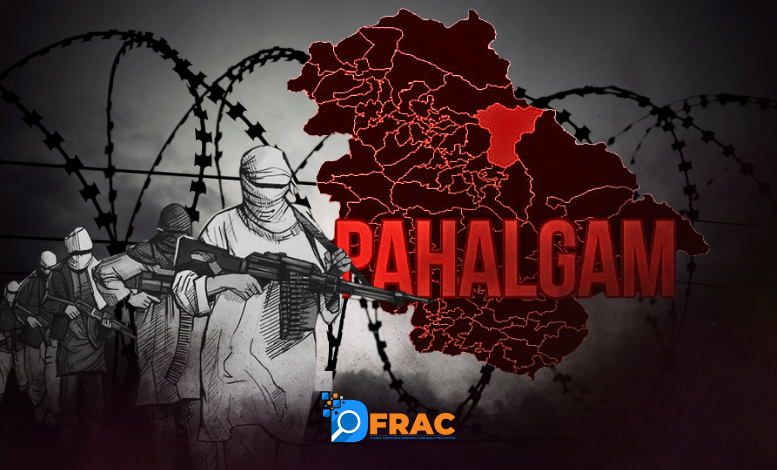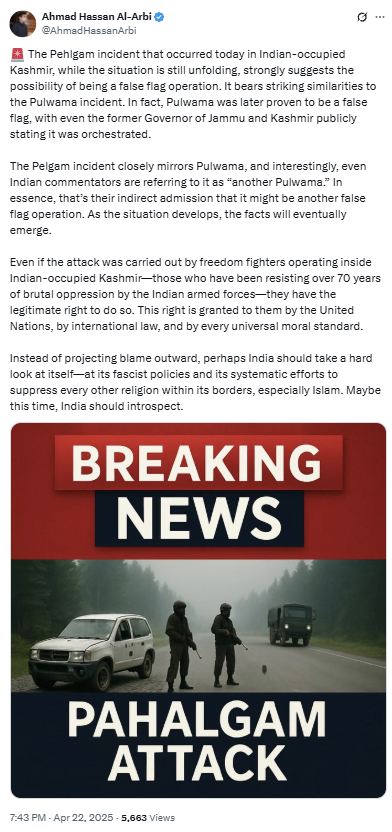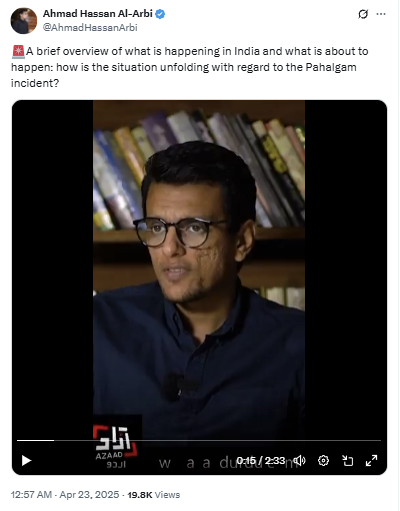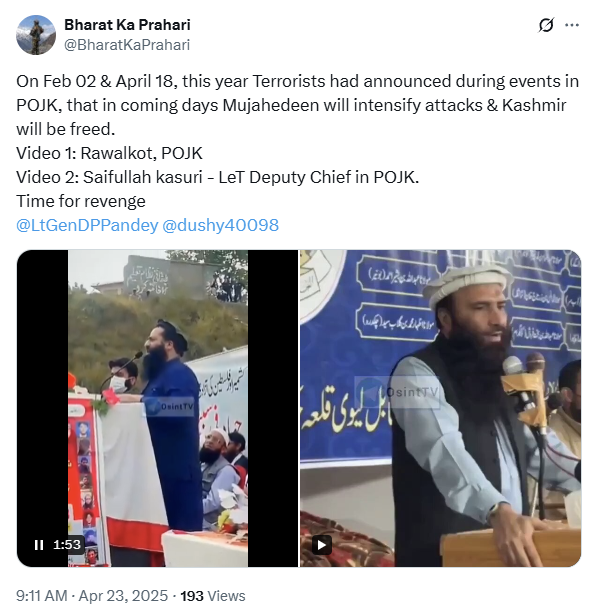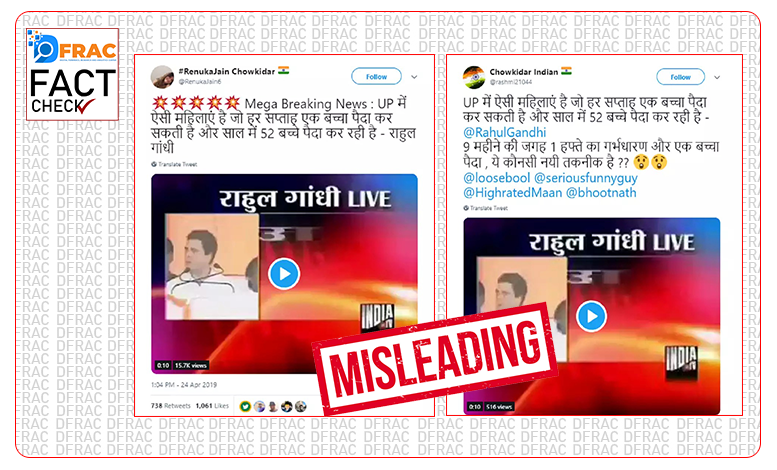The horrific terrorist attack of April 22, 2025, in Pahalgam, Jammu & Kashmir, which claimed the lives of numerous civilians, was almost instantly followed by the insidious emergence of a narrative accusing Indian authorities of staging the atrocity as a “false flag operation.” Alarmingly, on the very day of this tragedy, a staggering four out of the top five trending topics on Twitter in Pakistan were fixated on India. This report applies a systematic, evidence-driven approach to map out how this narrative was constructed, amplified and sustained online via Pakistani Social media users.
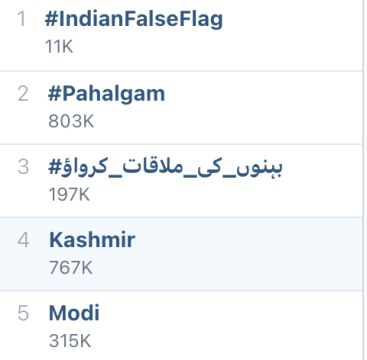
Key points covered in the report
- Initiation of the Narrative
- Militant Build-Up & Operational Coordination
- Transnational False-Flag Amplification
1.1 Khalistani Networks
1.2 Bangladeshi Networks
1.3 Facebook Echo Chambers - Hashtag Analysis
- Bot Detection & Network Dynamics
- Sentiment & Thematic Analysis
- Conclusion
Initiation of the narrative:
At 7:43 PM India Standard Time on April 22, 2025, a Twitter user named Ahmad Hassan Al-Arbi posted a thread that sparked controversy. He suggested that the terrorist attack in Pahalgam was a “false flag operation” carried out by Indian government agencies. This initial tweet became the starting point for many similar claims that quickly spread through Pakistani social media and news channels. Within a short time, well-known Pakistani news organizations like ARY News began to highlight this perspective, giving it more credibility within Pakistan.

This user further mocked the survivor’s videos with such statements, “ The husband of this lady went missing immediately after eating Bhelpuri. Anyone who finds him, please parcel him to the headquarters of the Rashtriya Rifles.”
Syed Zaid Zaman Hamid—Pakistan’s most prominent far-right, Islamist conspiracy theorist—and Ahmad Hassan Al-Arbi—a self-styled international relations scholar and defence analyst on X—have forged a collaborative platform for advancing “false-flag” narratives. Their alliance is cemented by joint podcast appearances and parallel online commentaries, both portraying major security incidents as Indian state-orchestrated deceptions.
Ahmad Hassan Al-Arbi operates the Great Game Pakistan channel on YouTube and social platforms, framing geopolitical developments through a Pakistan-centric lens YouTube. He regularly features Syed Zaid Zaman Hamid—Pakistan’s leading far-right conspiracy commentator—to dissect real-time events and allege Indian malfeasance.
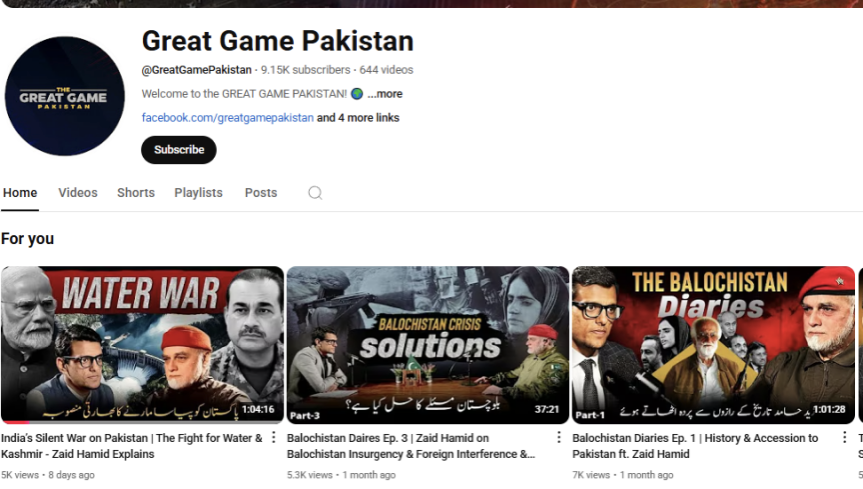

Zaid Hamid’s Ideological Profile
Zaid Hamid is widely characterized as a far-right, radical Islamist commentator who fuses militant Pakistani nationalism with conspiratorial geopolitics. He has repeatedly labeled high-profile attacks—such as the 2008 Mumbai strikes and even 9/11—as “Hindu Zionist” or Western false-flag operations.
He openly endorses jihad, supports intrusions of the Pakistan Army into governance, and campaigns against democratic processes in favour of an Islamic system of rule Wikipedia.
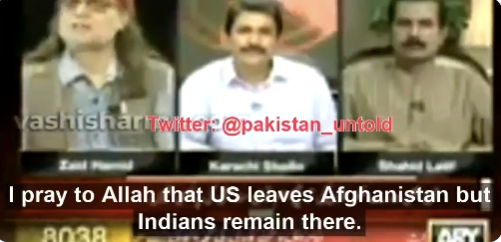
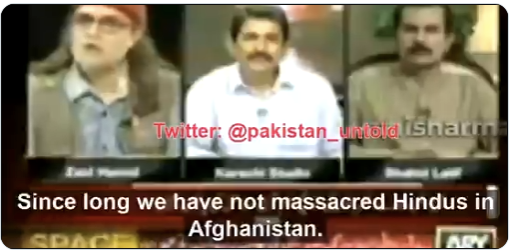
This interpretation differed significantly from the official statements coming from The Resistance Front (TRF), a militant group that claimed responsibility for the attack shortly after it happened. Indian investigators supported this claim by identifying Saifullah Kasuri, a known operative of Lashkar-e-Taiba, as the main attacker.
A detailed report by DFRAC has explored the origins of The Resistance Front (TRF), its connections to Pakistan’s Inter-Services Intelligence (ISI) and the Lashkar-e-Taiba (LeT). The report also includes information on the background of TRF’s founders and their use of social media to spread their narrative. This comprehensive report is available for further reading here.
The events leading up to the attack in Pahalgam suggest a clear build-up and coordinated effort. As early as February 2, 2025, militants connected to Lashkar-e-Taiba (LeT) spoke at a gathering in Pakistan-occupied Jammu and Kashmir (PoJK), indicating an increase in militant activity. They stated that “in the coming days, Mujahideen will intensify attacks, and Kashmir will be freed” (as seen in Video 1 from Rawalkot, PoJK). This warning was repeated just a few days before the Pahalgam bombing, on April 18, when Saifullah Kasuri, the LeT deputy chief in PoJK, gave a similar message (Video 2), effectively mobilizing grassroots cadres and priming local networks for action. Five days later, on April 23, Kasuri was identified as the main person responsible for the Pahalgam attack. This suggests that the attack was not only planned in advance but was also carried out under the leadership of someone who had publicly called for action in the weeks and days prior.
Khalistani and Bangladeshi accounts Supports:
Khalistani activists quickly adopted the idea that the Pahalgam attack was a “false flag operation” to further their goals of a separate Sikh state. They incorporated this narrative into their political statements and online content to support their claims of government-sponsored oppression in Kashmir.
For example, a tweet from @NyJagdeepsingh stated that the Pahalgam attack was a “false flag operation” by Indian government agencies, echoing the narrative put forth by the Sikhs for Justice (SFJ). By portraying the killings as a deliberate plot against Hindu civilians, the tweet connects with the Khalistani movement’s wider aim to highlight alleged government mistreatment of minorities in Kashmir, linking it to their own fight for Khalistan. This message was supported by a public statement from Gurpatwant Singh Pannun of the SFJ, who called the attack a “false flag operation.” He also announced a $500,000 aid package for the victims and explicitly linked the idea of Kashmir’s independence to the creation of Khalistan. The repetition of this narrative within the Khalistani network was amplified through SFJ’s online platforms, including an Instagram video questioning who benefited from the violence and YouTube videos suggesting the involvement of India’s Research and Analysis Wing (RAW).
Tweets from @JSDhaliwal_USMI and @sarkar6432 closely resembled the statement issued by Sikhs for Justice (SFJ). These tweets condemned the killings in Pahalgam but also claimed they were a “false flag operation” orchestrated by the BJP-led Indian government to undermine minority movements. Both accounts emphasised SFJ’s promise of half a million dollars in “humanitarian aid” as evidence of their sincerity and ended with the slogan, “The road to Kashmir’s independence runs through Khalistan.” By using the same wording and visuals as SFJ (including flag icons and emphasised capitalization), these tweets helped to spread the separatist narrative and give it a sense of wider validation across borders.

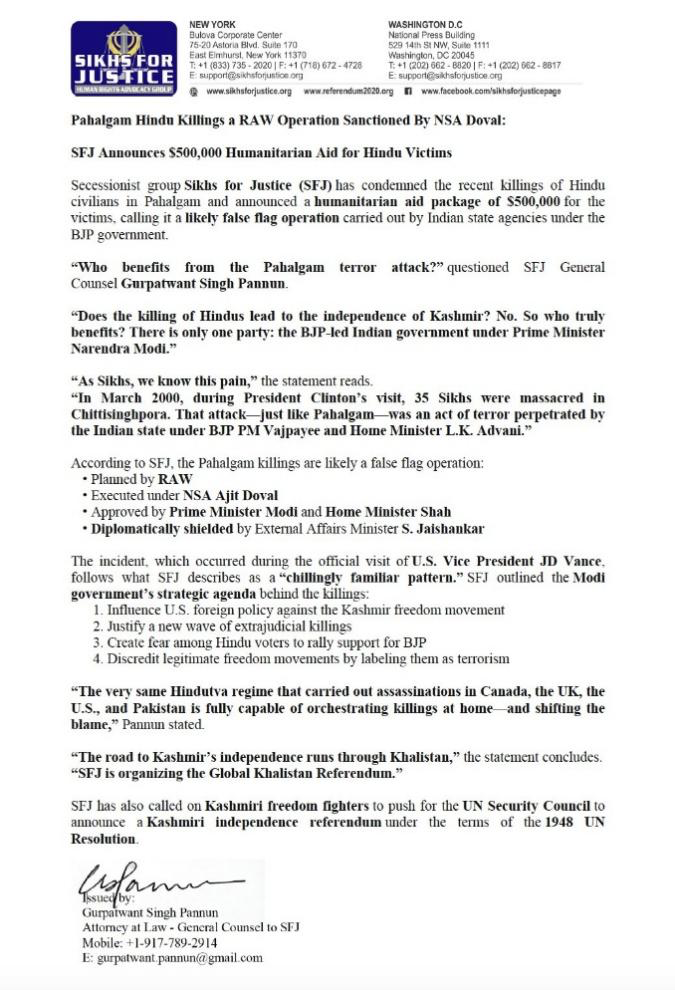
Bangladeshi Partisan Copy-Paste Campaign
The X-account @revolt_71, linked to Bangladesh’s BNP political network, posted the SFJ text verbatim in Bengali script. This wholesale copy-paste strategy signals low-effort coordination rather than organic debate. By echoing SFJ’s claims without attribution or additional context, these accounts helped seed the false-flag narrative among Bangladeshi audiences, who might be more inclined to view it through the prism of regional suspicion toward Indian policy.
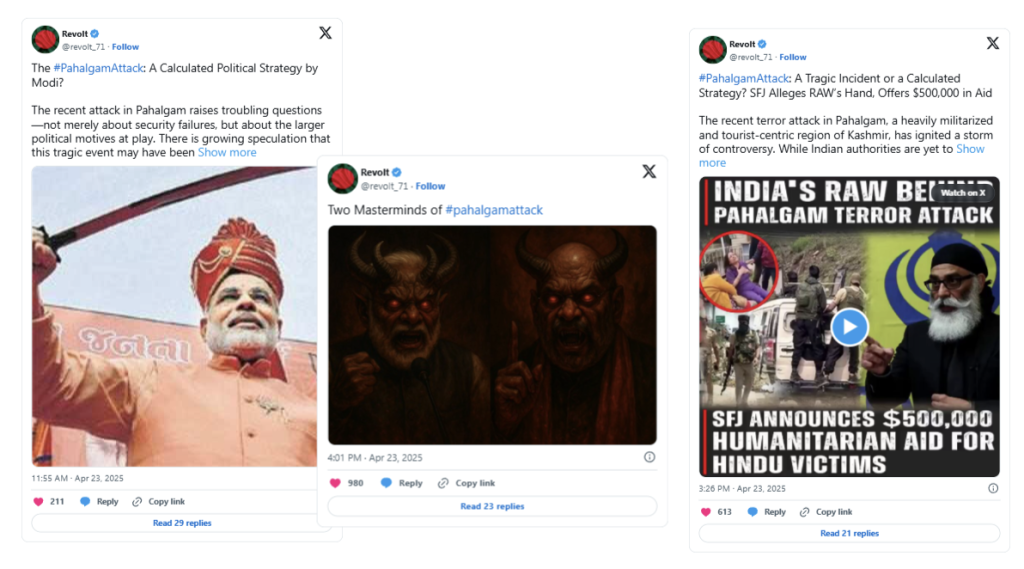
Facebook’s Bengali-Language Echo Chambers
On Facebook, a similar narrative suggesting a “false flag” operation was shared by Bangladeshi users in Bengali across multiple posts. These posts used what they described as a “perfect” sketch of the attacker as visual “proof.” The posts raised questions like, “How was such a perfect sketch created?” They contrasted this with accounts from “terrified” witnesses and suggested that Indian authorities might have reused images of known freedom fighters to create the sketch. By presenting it as a puzzle (“Is it a coincidence?”) rather than directly denying the official account, these posts encouraged readers to speculate and potentially believe the conspiracy. The repeated use of suggestive language, such as “media propaganda” and “deliberately created,” along with the consistent sharing of these posts across different pages, indicates a coordinated effort to establish the false-flag narrative within the Bangladeshi social media environment.
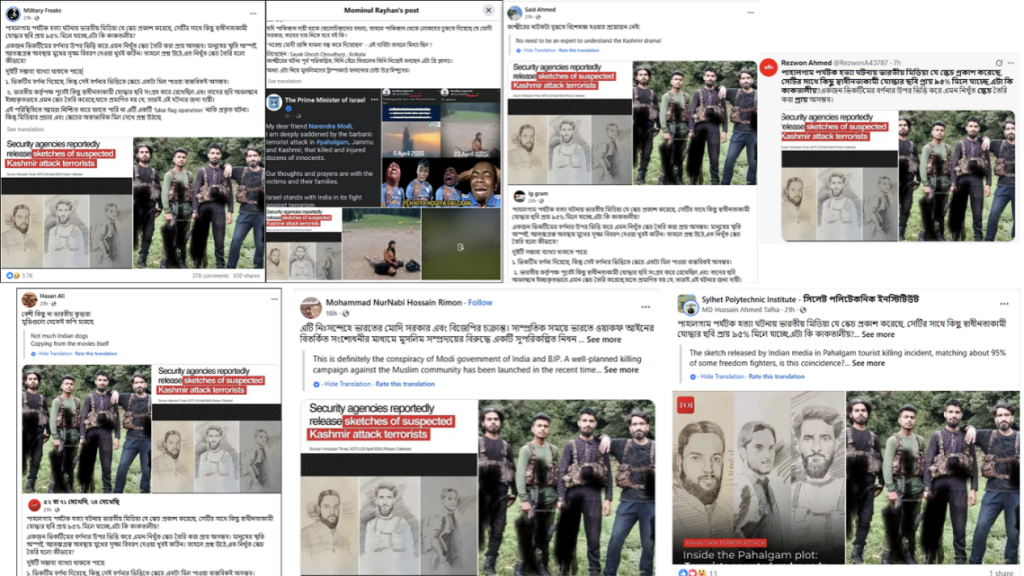
Hashtag Analysis: Mapping the Digital Surge of the False Flag Narrative
Before diving into the detailed metrics, it’s important to understand why we analyzed hashtags in this investigation. Hashtags like #IndianFalseFlag and #IndiaFalseFlagKing served as rallying points for online communities, enabling us to quantify the scale, timing and thematic connections of the false-flag narrative. By tracking tweet volumes, impression counts, peak activity windows and co-occurring tags, we mapped how rapidly the claim gained traction, identified key amplification moments, and revealed the broader framing—such as calls for #FreeKashmir—that accompanied the core narrative.we must
Data Collection
To understand the scale and structure of the digital discourse surrounding the Pahalgam attack, two primary Twitter datasets were analyzed.
#IndianFalseFlag: ~700 tweets harvested between 21:30 IST on 22 April and 23:59 IST on 23 April 2025.

#IndiaFalseFlagKing: ~681 tweets over the same time window
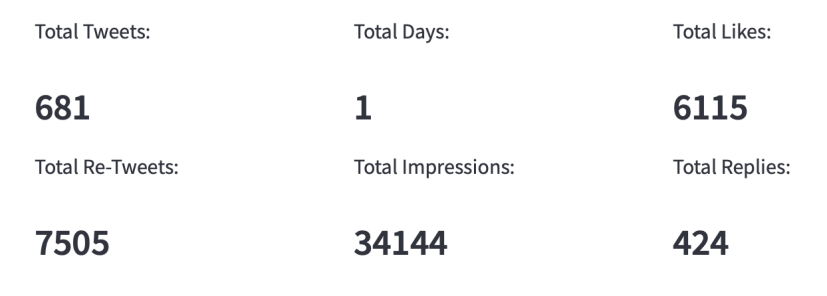
According to the timeline of the 681 tweets under the hashtag #IndiaFalseFlagKing, it was noticed that 276 tweets were done on 05:00 UTC, i.e. 10:30 AM IST on 23 April 2025.

Another hashtag that has been found being used by Pakistani accounts is #PehalgamDramaExposed.
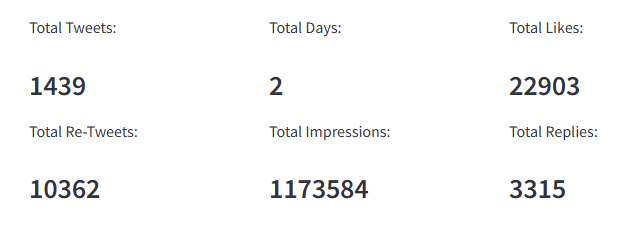
These datasets provided insight into how the false flag narrative was seeded and circulated across the platform. Additionally, the investigation extended to Facebook, where six public Bangladeshi pages were manually identified and archived using keyword searches such as “Pahalgam false flag.” These pages played a key role in localizing and echoing the same narrative in Bengali.
Co-occurrence Patterns:

Top co-hashtags across both sets: #IndianFalseFlagExposed, #FreeKashmir, #StopIndianStateTerror—appearing in 18–22% of posts.
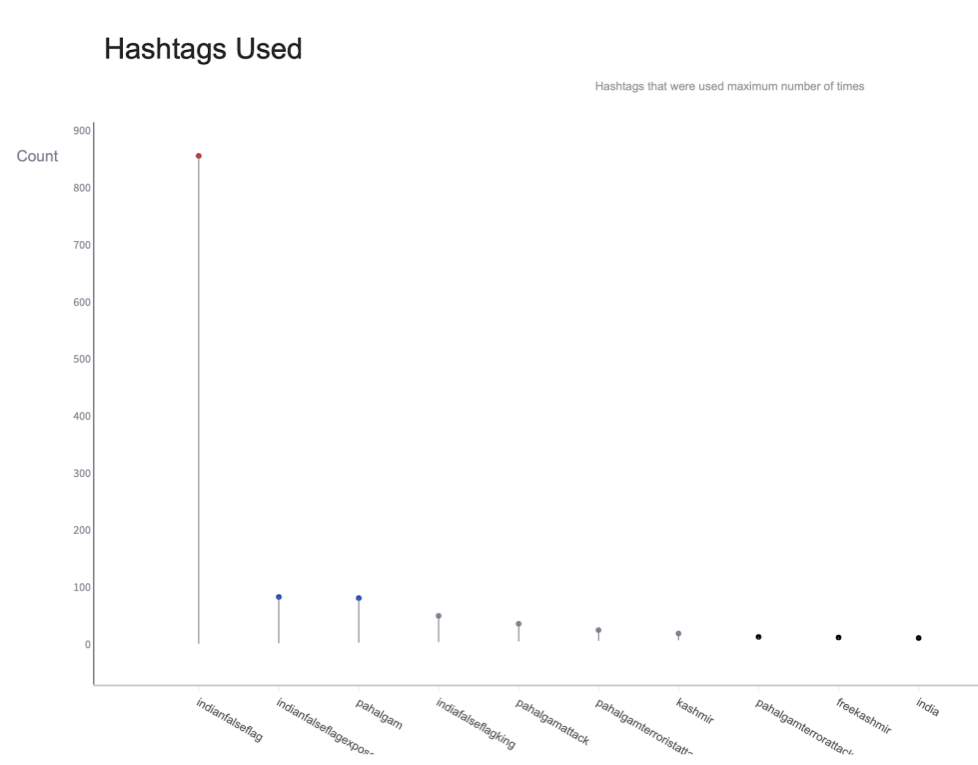
Bot Detection Heuristics:
A network of at least 20 Pakistani bot accounts systematically amplified #IndiaFalseFlagKing through synchronized retweeting bursts. These accounts, although created way before with large followers and default profile images, still exhibited striking content uniformity—often retweeting identical text within 60–120 seconds of each other . Such temporal synchrony and high retweet ratios (> 90% in sampled accounts) are hallmark indicators of inauthentic amplification designed to manufacture trending momentum.

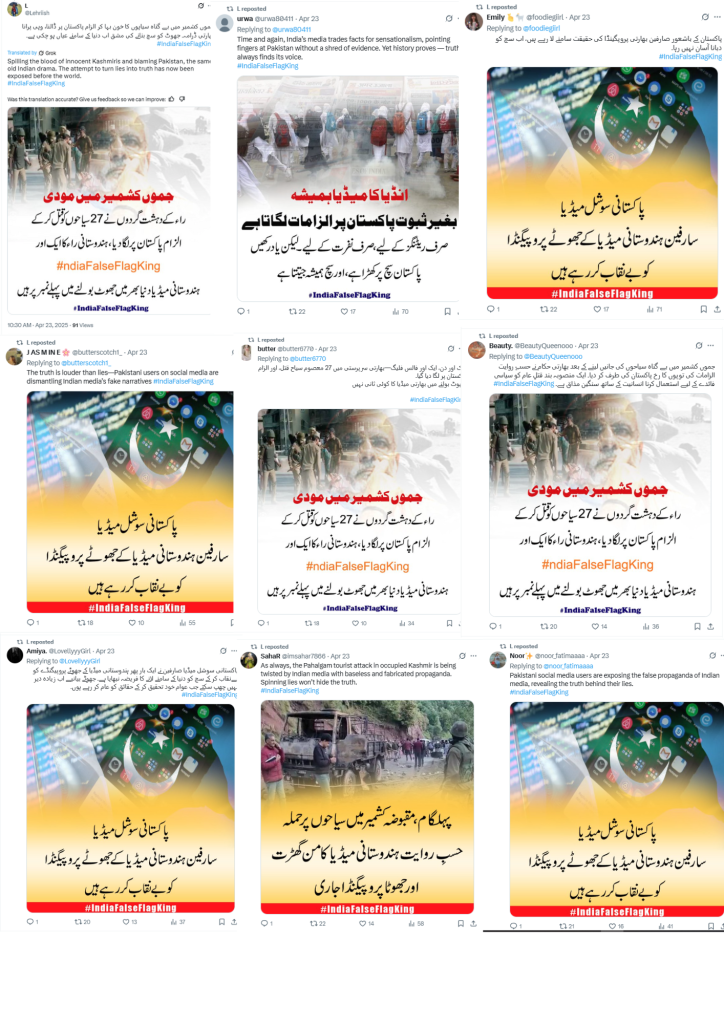
Early Tweets with Concerning Hashtags:
The earliest tweet identified using the hashtag #IndianFalseFlag was posted by @MaheenHun___ at 21:32 IST on April 22.

Journalist Wajahat Kazmi @KazmiWajahat, who worked with Dawn News, Samaa TV, Star News and based in Karachi, Pakistan also tweeted at 22:05 IST on April 22, 2025.
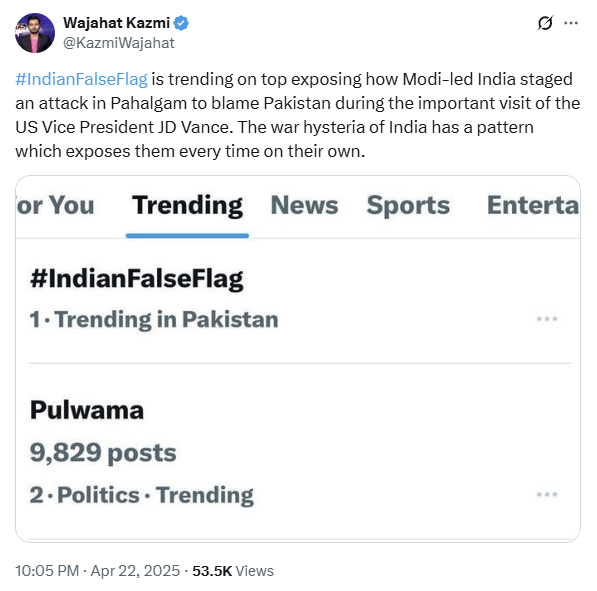
Sentiment Analysis:
What are the sentiments of the tweets?
The sentiments expressed in the tweets under #Indiafalseflag are overwhelmingly negative towards India. The tweets consistently accuse India of staging the Pahalgam attack as a false flag operation to falsely implicate Pakistan. Key emotional tones include:
- Distrust: Users question the authenticity of India’s narrative about the attack.
- Skepticism: There’s a belief that India is engaging in deceptive tactics.
- Criticism: India is portrayed as manipulative and habitual in creating “war hysteria.”
What is the narrative of the tweets towards India?
The narrative from these tweets towards India is highly critical and accusatory, portraying India as the orchestrator of the Pahalgam attack to unjustly blame Pakistan. Key themes include:
- False Flag Accusation: India is alleged to have staged the attack as a deliberate deception. For example, @GFarooqi writes, “The usual Indian obsession with Pakistan… indicates all the signs of a false flag operation/inside job!”
- Geopolitical Motivation: The tweets suggest India’s actions are driven by envy of Pakistan’s growing global influence and economic progress, as well as a desire to manipulate international perception during events like the US Vice President’s visit. @chsandhilaa notes, “Pakistan is gaining global importance… that’s exactly what’s bothering India, hence the drama.”
- Rapid Blame: Users highlight the speed with which Pakistan was blamed, implying premeditation. @PashtunWali79 states, “exactly after five minute,s RAW troll account puts blame on Pakistan… Proves #IndianFalseFlagExposed.”
Conclusion:
Moments after the Pahalgam atrocity, a different story began to take shape online—one that claimed the attack was a “false flag” staged by Indian authorities. What started as a single provocative tweet quickly swelled into a transnational chorus: Khalistani activists chimed in, and almost at the same time, Bangladeshi X accounts and Facebook pages in Bengali-languageechoed the exact same narrative. Yet beneath this show of grassroots solidarity lay a hidden engine: at least twenty Pakistani bot accounts orchestrated synchronized retweets under #IndiaFalseFlagKing. The result? A stark reminder of how fragile our digital discourse can be in a crisis—how a misleading narrative can drown out verified facts, erode trust, and widen geopolitical divides.
This report was compiled using user-provided data on social media activity and applies standard digital forensics methodologies to dissect the spread of the false-flag narrative around the Pahalgam attack.


